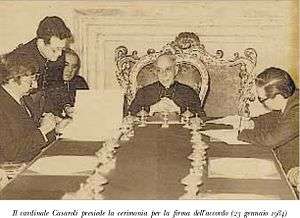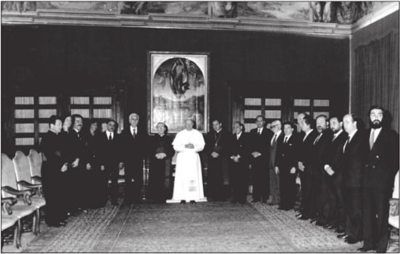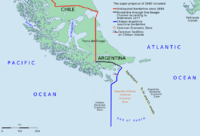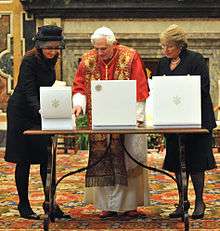Papal mediation in the Beagle conflict
| The Beagle Conflict | |
|---|---|
 | |
| Main: | Beagle conflict |
| 1881–1970: | Beagle Channel cartography |
| 1958: | Snipe incident |
| 1971–1977: | Beagle Channel Arbitration |
| 1977–1978: | Direct Negotiations |
| 1978: | Operation Soberanía |
| 1979–1984: | Papal Mediation |
| 1984: | Treaty of Peace and Friendship |

The Papal mediation in the Beagle conflict followed the failure of negotiations between Chile and Argentina, when, on 22 December 1978, the Argentinian Junta started Operation Soberanía, to invade Cape Horn and islands awarded to Chile by the Beagle Channel Arbitration. Soon after the event, Pope John Paul II, offered to mediate and sent his personal envoy Cardinal Antonio Samoré to Buenos Aires. Argentina, in acceptance of the authority of the Pope over the overwhelmingly Catholic Argentine population, called off the military operation and accepted the mediation. On 9 January 1979 Chile and Argentina signed the Act of Montevideo formally requesting mediation by the Vatican and renouncing the use of force.
Interests of the parties
The mediator acted to defuse the situation by negotiating an agreement that stopped the immediate military crisis. Then, the Vatican crafted a six-year process that allowed the parties to grapple with increasingly difficult issues, including navigation rights, sovereignty over other islands in the Fuegian Archipelago, delimitation of the Straits of Magellan, and maritime boundaries south to Cape Horn and beyond.
- Chile considered the Arbitral Award of 1977 "…fully operative and obligatory in law…" as expressed by the Court of Arbitration after the Argentine Refusal.[1]
- Argentina repudiated the International Arbitral Award that the government of Alejandro Lanusse had solicited in 1971.
- Argentina extended its claim to all territories southward of Tierra del Fuego and eastward of the Cape Horn-meridian. That is, Argentina claimed the islands Horn, Wollastone, Deceit, Barnevelt, Evouts, Herschell, etc.
The 1978 military mobilization revealed other latent international relations issues between the two countries that had been previously overlooked or ignored.
Mediator
By the beginning of November 1978, Chile and Argentina no longer had any mechanism for working toward a peaceful settlement and the situation began to destabilize rapidly. It was at this point, with direct talks dead and a judicial settlement refused by Argentina, that Chile suggested mediation. Argentina accepted the proposal and the two foreign ministers agreed to meet in Buenos Aires on December 12 for the purpose of selecting a mediator and the terms of mediation. Possible candidates were[2]
- Jimmy Carter, President of the United States of America
- the Organization of American States,
- Juan Carlos I of Spain, King of Spain
- a European president
- Pope John Paul II
The ministers concurred on the issue that the Pope should mediate the dispute, but their agreement proved ephemeral. In the evening, as the Chilean delegation was studying the documents for signature, the Argentine minister called the Chilean minister Cubillos to tell him that President Videla, who had approved their choice of mediator, had been stripped of his authority by the junta.
On 22 December 1978, Argentina launched Operation Soberania to occupy the islands militarily. On the morning of December 22, Pope John Paul II, on his own initiative, contacted both governments directly to communicate that he was sending a personal envoy to Buenos Aires and Santiago.
- Mediator and the heads of state
 Raúl Alfonsín Argentine Head of State
Raúl Alfonsín Argentine Head of State Pope John Paul II mediator between Chile and Argentina
Pope John Paul II mediator between Chile and Argentina Augusto Pinochet Chilean Head of State
Augusto Pinochet Chilean Head of State
The Act of Montevideo
In Montevideo, Uruguay, on 8 January 1979 both countries signed the Act of Montevideo. In this treaty the parties agreed to:
- no restrictions whatsoever over the mediation (textual: «…they will raise no objection to the expression by the Holy See, during these proceedings, of such ideas as its thorough studies on a disputed aspects of the problem of the southern zone may suggest to it, with a view to contributing to a peaceful settlement acceptable to both Parties…»)
- «…Antonio Cardinal Samoré … asks that that request [of mediation] should be accompanied by an undertaking that the two States will not resort to the use of force in their mutual relations, will bring about a gradual return to the military situation existing at the beginning of 1977 and will refrain from adopting measures that might impair harmony in any sector.…».
The treaty gave the mediator a broad framework in which to negotiate without any geographical data or temporal restrictions.

List of members of the Chilean Delegation in Rome:
List of members of the Argentine Delegation in Rome:
|
|
Cardinal Antonio Samorè's principal assistant was the Spanish priest Monsignor Faustino Sainz Muñoz.
The four phases of the mediation
Mark Laudy[7] sees four phases during the mediation:
- The first phase was the shortest and most critical period of the entire mediation and began with Samorè's arrival in Buenos Aires on 25 December 1978. This was purely a crisis intervention to prevent a war and secure an agreement to submit the matter to mediation. In a shuttle diplomacy, Samorè flew between Santiago de Chile and Buenos Aires until the objectives were achieved with the signing of the Act of Montevideo on January 8, 1979.
- The second period ran from May 1979, when the Chilean and Argentine delegations arrived in Rome, through December 1980, when the Pope presented the parties with his proposal for settling the dispute. This first proposal was rejected by Argentina.
- The third and longest phase, running from the beginning of 1981 until December 1983, after Argentina's return to democracy, was characterized by long periods of stalled negotiations. The most significant developments during this period were the Argentine repudiation of the 1972 General Treaty; the subsequent effort to fill the juridical vacuum resulting from that repudiation; and the Falklands war, which set the stage for the return to democracy in Argentina.
- The final phase began when Raúl Alfonsín assumed the presidency in Buenos Aires at the end of 1983 and ended with the signing of the 1984 Treaty of Peace and Friendship.
The papal proposal of 1980

On December 12, 1980, the Pope received both delegations and communicated to them his proposal for resolving the controversy, the terms of which had been developed entirely in secret and should be kept secret in order to avoid debilitating public debate that might diminish confidence in the proceedings and limit the freedom of action of both governments. But on 22 August 1981 the Argentine newspaper La Nación published the terms of the proposal. Chile would retain all of the islands and Argentina would be entitled to maintain certain limited facilities (common Radar and Weather stations) on some islands and would receive important navigation rights. Most important, however, was the creation of an ocean area known as the Sea of Peace. In this area, extending to the east and southeast from the disputed chain of islands, Chilean territorial waters would be limited to a narrow territorial sea, in which it would be obliged to share with Argentina equal participation in resource exploitation, scientific investigation, and environmental management. Beyond the Chilean territorial waters would be a much broader band of ocean subject to Argentine jurisdiction, but also subject to the same sharing provisions that applied in Chilean waters.
Chile accepted the papal proposal, despite some reservations. Argentina never formally replied to the proposal. However, on March 17, 1981, Argentina delivered a note to the Vatican expressing grave misgivings about the proposal, both because it failed to award any islands to Argentina and because it allowed Chile to maintain a presence so far into the Atlantic.
Argentina renounced a 1972 Arbitration treaty
On January 21, 1982 Argentina announced the withdrawal from the 1972 bilateral treaty providing for recourse to the International Court of Justice in case of disputes. In Argentina the judicial process had become an anathema, particularly in view of the adverse 1977 arbitration award.[8] Chile reserved the right to go to the ICJ unilaterally before the treaty ended on 27 December 1982.[9]
To the Falklands war
After the papal proposal, negotiations remained stalled and meanwhile, a train wreck of incidents in Chile and Argentina strained relations between the two countries.
On 28 April 1981 General Leopoldo Fortunato Galtieri, (then Argentine army chief, later, during the Falklands war, President of Argentina), closed the border to Chile without any consultation with his own president.[10]
In March 1982, five weeks before the beginning of the Falklands war, a ship of the Argentine navy, ARA Francisco de Gurruchaga, anchored at the Deceit island, de facto under Chilean sovereignty since 1881, and refused to abandon the bay despite Chilean demands[11][12]
On 2 April 1982 Argentina invaded the Falkland Islands. The Argentine plan included indeed the military occupation of the disputed islands at the Beagle channel after the invasion of the Falklands, as stated by Brigadier Basilio Lami Dozo, chief of the Argentine Air Force during the Falklands war, in an interview with the Argentine magazine Perfil: L.F. Galtieri:"[Chile] have to know that what we are doing now, because they will be the next in turn..[13] Also Óscar Camilión, Minister for Foreign Affairs of Argentina from 29 March 1981 to 11 December 1981, in his "Memorias Políticas", confirms the plan of Argentine military: "The military planning was, with the Falklands in Argentine hand, to invade the disputed islands in the Beagle Channel. That was the determination of the [Argentine] navy…".[14] Pope John Paul II made an unscheduled visit to Buenos Aires on June 14, 1982 in an attempt to prevent further hostilities between Britain and Argentina.
Chile became the only major Latin American country to support Britain indirectly by providing a military and naval diversion, but "in private many [Latin American] governments were pleased with the outcome of the war".[15]
The final phase
After the war, yet despite the renewal of the 1972 Treaty on 15 September 1982, the distension after ARA-Gurruchaga incident and the spy-exchanging, the mediation continued to move very slowly. Following the war Chile evinced a greater willingness to negotiate modifications to the papal proposal, but by then it had become clear that the Argentine junta, reeling from its defeat in the war, was too weak to achieve an agreement.
Cardinal Antonio Samorè died in Rome at age 77 in February 1983.
President Raúl Alfonsín's new government was firmly committed to resolve the conflict as quickly as possible. Based on this commitment and additional discussions, the parties were able to lay much of the groundwork for a settlement.
In April 1984, Vatican Secretary of State Agostino Casaroli asked separately the two delegations for their proposals for a final solution.
By October 1984, both countries reached a complete understanding, and the revised text of the treaty was finalized on October 18.
Chile accepted, again, the papal proposal. In Argentina, Alfonsin held a consultative referendum. The official returns showed 10,391,019 voted in favor of the proposed treaty while 2,105,663 opposed it. A margin of 82 percent to 16 percent opposed, with 2 percent casting blank or null ballots.[16]
The Treaty of Peace and Friendship of 1984 between Chile and Argentina went a long way before enacted:
- on 30 December 1984 the treaty passed the Argentine Chamber of Deputies,
- on 15 March 1985 the treaty passed the Argentine Senate,
- on 16 March 1985 was signed by representant of the President of Argentina, who was abroad,
- on 11 April 1985 the treaty passed the Chilean junta,
- on 12 April 1985 was signed by Augusto Pinochet,
- on 2 May 1985 both ministers exchanged instruments
Aftermath

The Cardenal Antonio Samoré Pass crossing border was renamed to honour the special representative of Pope John Paul II.
See also
Notes
- ↑ See "Der Schiedsspruch in der Beagle-Kanal-Streitigkeit", Karin Oellers-Frahm, Page 353
- ↑ See Alejandro Luis Corbacho: Predicting the Probability of War During Brinkmanship Crises: The Beagle and the Malvinas Conflicts, Universidad del CEMA, Argentina, Documento de Trabajo No. 244, September 2003, page 8
- 1 2 3 4 See article of Pedro Daza Valenzuela in
- 1 2 See "Pasion de Servicio: Julio Philippi Izquierdo" in of René Millar Carvacho
- 1 2 See book by Enrique Bernstein Carabantes "Recuerdos de un diplomático", Vol. 4, pág. 65
- 1 2 Ver "Chile-argentina, más allá de sus fronteras: Crónicas de un diplomático" de Eduardo Rodríguez Guarachi, RIL Editores, 2004 ISBN 956-284-389-0, 978-956-284-389-8,233 páginas, en página 102
- ↑ Mark Laudy, "The Vatican Mediation of the Beagle Channel Dispute: Crisis Intervention and Forum Building"
- ↑ See Michael Morris, "The Strait of Magellan", Martinus Nijhoff Publishers, 1989, page 85
- ↑ See article Argentina denuncia el tratado con Chile sobre el Beagle in Spanish newspaper El País on 23 January 1982 (in spanish language).
- ↑ See article Historia de la santa mediación in Argentine newspaper Clarín, Buenos Aires, on 20 December 1998: «Me calenté, se justificó Galtieri ante el fastidiado comandante de la Marina, almirante Lambruschini, quien le preguntó: Pero se da usted cuenta que el país se encuentra así envuelto en una peligrosa escalada?» (Translation; I lost my cool, justify himself Galtieri, as the annoyed Chief of the Argentine Navy, Admiral Lambruschini, asked him: Don't you notice that it bring the country in a dangerous escalation?)
- ↑ See article Pinochet ordena el acuartelamiento de las tropas chilenas por el conflicto con Argentina sobre el canal de Beagle in spanish newspaper El País on 6 March 1982 (in Spanish language).
- ↑ William Ben Hunt, Getting to war: predicting international conflict with mass media indicators, page 22
- ↑ Argentine magazine Perfil on 22 November 2009, retrieved on 22 November 2009:
- Para colmo, Galtieri dijo en un discurso: "Que saquen el ejemplo de lo que estamos haciendo ahora porque después les toca a ellos".
- ↑ Editorial Planeta, Buenos Aires, 1999, page 281«Los planes militares eran, en la hipótesis de resolver el caso Malvinas, invadir las islas en disputa en el Beagle. Esa era la decisión de la Armada…»
See also Kalevi Jaakko Holsti, The State, War, and the State of War Cambridge Studies in International Relations, 1996, 271 pages, ISBN 0-521-57790-X. See also here On page 160:
- Displaying the mentality of the Argentine military regime in the 1970s, as another example, there was "Plan Rosario" according to which Argentina would attack the Malvinas and then turn to settle the Beagle Channel problem by force. The sequence, according to the plan, could also be reversed.
- Para nosotros no lo estará [terminada la guerra], porque, inmediatamente después de barrido el enemigo de las Malvinas, debe serlo de las Georgias, Sandwich del Sur y de todos los demás archipiélagos australes argentinos, ...
- no persistir en una diplomacia bilateral que durante años la ha inhibido para efectuar actos de posesión efectiva en las islas en litigio que son los hechos reales que garantizan el establecimiento de una soberanía usurpada y la preservación de la integridad del territorio nacional. (cited in A treinta años de la crisis del Beagle, Desarrollo de un modelo de negociación en la resolución del conflicto by Renato Valenzuela Ugarte and Fernando García Toso, in Chilean Magazine "Política y Estrategia", nr. 115)
- ↑ See K.J. Holsti, "The state, war, and the state of war", page 176
- ↑ See article Beagle Channel Treaty Approved in Argentina in USA-newspaper The New York Times on 26 November 1984
- ↑ See newspaper Clarin of Buenos Aires on Los Kirchner rechazaban el acuerdo (tranl.: "The Kirchners rejected the agreement") on Saturday 28, November 2009, retrieved on 17 August 2010
References
- Beagle Channel Arbitration between the Republic of Argentina and the Republic of Chile, Report and Decision of the Court of Arbitration
- Mark Laudy: The Vatican Mediation of the Beagle Channel Dispute: Crisis Intervention and Forum Building in Words Over War of Carnegie Commission on Preventing Deadly Conflict.
- Alejandro Luis Corbacho: Predicting the Probability of War During Brinkmanship Crises: The Beagle and the Malvinas Conflicts, Universidad del CEMA, Argentina, Documento de Trabajo No. 244, September 2003, Spanish Language
- Karin Oellers-Frahm: Der Schiedsspruch in der Beagle-Kanal-Streitigkeit, Berichte und Urkunden: Max-Planck-Institut für ausländisches öffentliches Recht und Völkerrecht, German Language
- Ministerio de Relaciones Exteriores de Chile: Relaciones Chileno-Argentinas, La controversia del Beagle. Genf 1979, English and Spanish Language
- Andrea Wagner: Der argentinisch-chilenische Konflikt um den Beagle-Kanal. Ein Beitrag zu den Methoden friedlicher Streiterledigung. Verlag Peter Lang, Frankfurt a.M. 1992, ISBN 3-631-43590-8, German Language
- Karl Hernekamp: Der argentinisch-chilenisch Grenzstreit am Beagle-Kanal. Institut für Iberoamerika-Kunde, Hamburg 1980, German Language
- Andrés Cisneros y Carlos Escudé, "Historia general de las Relaciones Exteriores de la República Argentina", Las relaciones con Chile, Cema, Argentina, Buenos Aires. Spanish Language
- Annegret I. Haffa: Beagle-Konflikt und Falkland (Malwinen)-Krieg. Zur Außenpolitik der Argentinischen Militarregierung 1976–1983. Weltforum Verlag, München/Köln/London 1987, ISBN 3-8039-0348-3, German Language
- Isaac F. Rojas und Arturo Medrano: Argentina en el Atlántico Chile en el Pacífico. Editorial Nemont, Buenos Aires, Argentina, 1979, in spanischer Sprache.
- Isaac F. Rojas, La Argentina en el Beagle y Atlántico sur 1. Parte. Editorial Diagraf, Buenos Aires, Argentina, Spanish Language
- Carlos Escudé und Andrés Cisneros: Historia general de las relaciones exteriores de la República Argentina (here), in spanischer Sprache.
- Fabio Vio Valdivieso: La mediación de su S.S. el Papa Juan Pablo II, Editorial Aconcagua, Santiago de Chile, 1984, Spanish Language
- Alberto Marín Madrid: El arbitraje del Beagle y la actitud Argentina. 1984, Editorial Moisés Garrido Urrea, id = A-1374-84 XIII, Spanisch Language
- Luis Alberto Romero, Argentina in the twentieth Century. Pennsylvania State University Press, translated by James P. Brennan, 1994, ISBN 0-271-02191-8
- Divisionsgeneral (a.D.) Juan E. Gugliamelli: Cuestión del Beagle. Negociación directa o diálogo de armas (Trans.:The Beagle-Question, direct Negotiations or Dialog of the Weapons), in Spanish Language. (Book compiled from articles of Argentine Magazin "Estrategia", Buenos Aires Nr:49/50, enero-febrero 1978, erschienen sind.)
- General Martín Antonio Balza und Mariano Grondona: Dejo Constancia: memorias de un general argentino. Editorial Planeta, Buenos Aires 2001, ISBN 950-49-0813-6, Spanish Language
- Francisco Bulnes Serrano und Patricia Arancibia Clavel: La Escuadra En Acción. Chile, Editorial Grijalbo, 2004, ISBN 956-258-211-6, Spanish Language
External links
| Wikimedia Commons has media related to Beagle Conflict. |
- Chilean Telecast of Televisión Nacional de Chile "Informe Especial", Theme El año que vivimos en peligro, (sometimes in YouTube), Spanish Language
- Argentine Telecast of History Channel: Operativo Soberanía YouTube, Spanish Language
- Special edition of El Mercurio, Santiago de Chile, 2 September 2005, Spanish Language. There are Interviews with contemporary witness like Ernesto Videla, Jaime Del Valle, Helmut Brunner, Marcelo Delpech und Luciano Benjamín Menéndez. Spanish Language.
- Interview with the (later, in the nineties) Chief Commander of the Argentine Army Martín Balza in El Mercurio de Santiago de Chile, 2 September 2005, Spanish Language
- Interview with Sergio Onofre Jarpa, Chile's Ambassador in Argentina 1978 to 1982 in La Tercera, Santiago, Chile, 17 March 2002, Spanish Language
- Interview with Argentine General Luciano Benjamín Menéndez, Commandant of the III Army Corps in El Mercurio de Santiago de Chile, (from the Argentine Magazine "Somos"), Spanish Language
- Interview with Pio Laghi, Nuntius in Argentina, 1978, in Clarín, Buenos Aires, 20 December 1998. Spanish Language
- Interview with the Ambassador of the United States of America in Argentina, Raúl Héctor Castro, in Clarín Buenos Aires, 20 December 1998, Spanish Language
- Interview with the former Chief of the "Secretaría General del Ejército" (a Think-Tank of the Argentine Army), General Reynaldo Bignone, President of Argentina after the Falkland War, in Clarín, Buenos Aires, 20 December 1998, Spanish Language
- Article Cartas desde el Abismo, Clarín, Buenos Aires, 20 December 1998, Spanish Language
- Article El belicismo de los dictadores Clarín, Buenos Aires, 20 December 1998, Spanish Language
- Article Beagle: historia secreta de la guerra que no fue La Nación, Buenos Aires, 12. August 1996, Spanish Language
- Article Historia de la santa mediación en Clarín, Buenos Aires, 20 December 1998, Spanish Language
- Chile-Argentina Relations, Spanish Language
- Toma de decisiones políticas y la influencia de los discursos oficialistas durante el Connflicto del Beagle: Chile – Argentina 1977–1979, Spanish Language
- Text of the Tratado de Paz y Amistad de 1984, Dirección de Fronteras y Límites de Chile, Spanish Language
- Text of the Peace and Friendship Treaty of 1984, Copy to the United Nations, English Language
